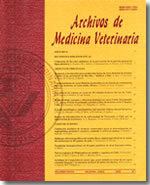Identification of lactic acid bacteria with bio-preservative potential isolated from contaminated avian blood obtained at the slaughterhouse
Main Article Content
Abstract
Blood is a common by-product of the meat industry, which has several potential applications in the animal feed industry. However, since blood is highly susceptible to microbial spoilage, blood and its fractions are often not suitable ingredients for the feed industry. Biopreservation appears as an alternative for the improvement of blood's quality towards its use as an ingredient in foodstuff. The objective of this work was to isolate and identify Lactic Acid Bacteria (LAB) in avian blood obtained from industrial slaughterhouses and evaluate their antimicrobial activity. Ninety-six LAB were isolated from avian blood and genotyped. Eleven Amplified rDNA Restriction Analysis groups were identified. Between two and five different species were detected in each blood sample (31 strains in all blood samples) which were selected to study antagonistic activity. Twenty-eight of them produced antimicrobial compounds such as organic acids, 11 strains produced hydrogen peroxide (H2O2) and two released bacteriocin-like compounds. The latter, identified as Lactobacillus salivarius (DSPV 027SA) and Enterococcus faecalis (DSPV 008SA), inhibited the growth of Escherichia coli, Pseudomonas aeruginosa and some serotypes of Salmonella spp.These two LAB strains would be candidates for potential application as a blood biopreservation system. This biotechnological tool is cheaper than others sanitation techniques and could reduce the risk of pathogens transmission thought food chain.

